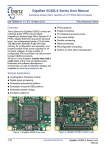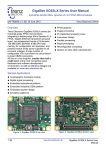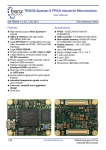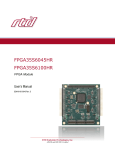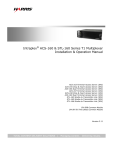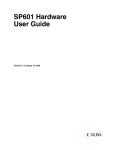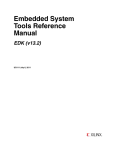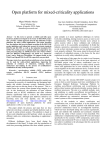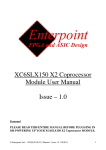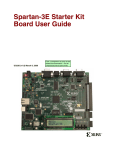Download GigaBee XC6SLX Series User Manual
Transcript
GigaBee XC6SLX Series User Manual Industrial-Grade Xilinx Spartan-6 LX FPGA Micromodules UM-TE0600-02 (v 2.07) 20 June 2013 Trenz Electronic GmbH Overview Trenz Electronic GigaBee XC6SLX series are industrial-grade FPGA micromodules integrating a leading-edge Xilinx Spartan-6 LX FPGA, Gigabit Ethernet transceiver (physical layer), two independent banks of 16-bit-wide 128/512 MBytes DDR3 SDRAM, 16 MBytes SPI Flash memory for configuration and operation, and powerful switch-mode power supplies for all on-board voltages. A large number of configurable I/Os is provided via robust board-to-board (B2B) connectors. All this on a tiny footprint, smaller than half a credit card, at the most competitive price. Hardware and software development environment, as well as reference designs are available at: www.trenz-electronic.de. ● ● ● ● ● ● ● ● FPGA graphics Image processing IP (intellectual property) cores Low-power design Parallel processing Rapid prototyping Reconfigurable computing System-on-Chip (SoC) development Sample Applications ● ● ● ● ● ● Cryptographic hardware module Digital signal processing Embedded educational platform Embedded industrial OEM platform Embedded system design Emulation platforms Figure 1: GigaBee XC6SLX top view 1/33 Figure 2: GigaBee XC6SLX bottom view www.trenz-electronic.de GigaBee XC6SLX Series User Manual UM-TE0600-02 (v 2.07) 20 June 2013 Key Features ● Industrial-grade Xilinx Spartan-6 LX FPGA micromodule (LX45 / LX100 / LX150) ● 10/100/1000 tri-speed Gigabit Ethernet transceiver (PHY) ● 2 x 16-bit-wide 1 Gb (128 MB) or 4Gb (512 MB) DDR3 SDRAM ● 128Mb (16 MB) SPI Flash memory (for configuration and operation) accessible through: ● 1Kb Protected 1-Wire EEPROM with SHA-1 Engine ● JTAG port (SPI indirect) ● FPGA configuration through: ● B2B connector ● JTAG port ● SPI Flash memory ● Plug-on module with 2 × 100-pin high-speed hermaphroditic strips ● Up to 52 differential, up to 109 single-ended (+ 1 dual-purpose) FPGA I/O pins available on B2B strips ● 4.0 A x 1.2 V power rail ● 1.5 A x 1.5 V power rail ● 125 MHz reference clock signal ● Single-ended custom oscillator (option) ● eFUSE bit-stream encryption (LX100 or larger) ● 1 user LED ● Evenly-spread supply pins for good signal integrity ● Other assembly options for cost or performance optimization available upon request. 2/33 www.trenz-electronic.de GigaBee XC6SLX Series User Manual UM-TE0600-02 (v 2.07) 20 June 2013 Table of Contents 1 Technical Specifications...............................................................................................................5 1.1 Components.........................................................................................................................5 1.2 Dimensions...........................................................................................................................6 1.3 Power Consumption.............................................................................................................7 2 Detailed Description.....................................................................................................................8 2.1 Block Diagram......................................................................................................................8 2.2 Power Supply.......................................................................................................................8 2.2.1 Power Supply Sources..................................................................................................9 2.2.2 FPGA banks VCCIO power supply...............................................................................9 2.2.3 On-board Power Rails.................................................................................................10 2.3 Power Supervision.............................................................................................................12 2.3.1 Power-on Reset..........................................................................................................12 2.3.2 Power Fail...................................................................................................................13 2.4 Board-to-board Connectors................................................................................................13 2.4.1 Connector Speed Rating.............................................................................................16 2.5 EPROM..............................................................................................................................16 2.6 DDR3 SDRAM Memory......................................................................................................16 2.7 Flash Memory.....................................................................................................................17 2.8 Ethernet..............................................................................................................................17 2.9 Oscillators...........................................................................................................................18 2.10 User LED..........................................................................................................................18 2.11 Watchdog..........................................................................................................................19 3 Configuration Options................................................................................................................20 3.1 JTAG Configuration............................................................................................................20 3.2 Flash Configuration............................................................................................................20 3.3 eFUSE Programming.........................................................................................................20 4 B2B Connectors Pin Descriptions.............................................................................................21 4.1 Pin Labelling.......................................................................................................................22 4.2 Pin Numbering....................................................................................................................22 4.3 Pin Types............................................................................................................................22 4.4 External Bank 2 differential clock connection....................................................................23 4.5 J1 Pin-out...........................................................................................................................23 4.6 J2 Pin-out...........................................................................................................................24 4.7 Signal Integrity Considerations..........................................................................................25 5 Module revisions and assembly variants...................................................................................25 6 Related Materials and References............................................................................................27 6.1 Data Sheets........................................................................................................................27 6.2 Documentation Archives.....................................................................................................27 6.3 User Guides........................................................................................................................27 6.4 Design and Development Tools.........................................................................................28 6.5 Design Resources..............................................................................................................28 6.6 Tutorials..............................................................................................................................28 7 Glossary of Abbreviations and Acronyms..................................................................................29 8 Legal Notices.............................................................................................................................30 8.1 Document Warranty............................................................................................................30 8.2 Limitation of Liability...........................................................................................................30 8.3 Copyright Notice.................................................................................................................30 8.4 Technology Licenses..........................................................................................................30 9 Environmental protection...........................................................................................................31 3/33 www.trenz-electronic.de GigaBee XC6SLX Series User Manual UM-TE0600-02 (v 2.07) 20 June 2013 9.1 REACH (Registration, Evaluation, Authorisation and Restriction of Chemicals) compliance statement..............................................................................................................31 9.2 RoHS (Restriction of Hazardous Substances) compliance statement..............................31 9.3 WEEE (Waste Electrical and Electronic Equipment).........................................................31 Document Change History..........................................................................................................33 4/33 www.trenz-electronic.de GigaBee XC6SLX Series User Manual 1 Technical Specifications UM-TE0600-02 (v 2.07) 20 June 2013 1 Technical Specifications 1.1 Components ● Xilinx Spartan-6 LX FPGA: ● XC6SLX45-2FGG484C = 43 K logic cells, commercial grade XC6SLX45-2FGG484I = 43 K logic cells, industrial grade ● XC6SLX100-2FGG484C = 101 K logic cells, commercial grade XC6SLX100-2FGG484I = 101 K logic cells, industrial grade ● XC6SLX150-2FGG484C = 147 K logic cells, commercial grade XC6SLX150-2FGG484I = 147 K logic cells, industrial grade ● 10/100/1000 Gigabit Ethernet transceiver (physical layer) Marvell Semiconductor 88E1111 ● 2 × independent 16-bit-wide (data-bus) 1 Gigabit (128 megabyte) or 4 Gigabit (512 megabyte) DDR3 SDRAM ● 128 megabit (16 megabyte) serial Flash memory with dual/quad SPI interface ● 48-bit node address chip Maxim Integrated Products DS2502-E48 ● 1Kb Protected 1-Wire EEPROM with SHA-1 Engine Maxim Embedded Security Products DS2432 ● 2 x fine-pitch (0.5 mm) 100-pin high-speed (up to 10.0 GHz / 20 Gbps) hermaphroditic strips LSHM-150-04.0-L-DV-A-S-K-TR ● Up to 52 differential FPGA input/output pins available on B2B strips ● Up to 109 single-ended (+ 1 dual-purpose) FPGA input/output pins available on B2B strips ● Ethernet (PHY), JTAG and SPI pins available on B2B strips ● 4.0 A high-efficiency DC-DC switching regulator for power rail 1.2V ● 1.5 A high-efficiency DC-DC switching regulator for power rail 1.5V ● 2 x 800 mA DC-DC linear regulator for power rails 2.5V and VCCAUX ● Processor supervisory circuits with power-fail and watchdog Texas Instruments TPS3705-33 ● 125 MHz clock signal (system + user) ● Footprint for custom single-ended oscillator (option) ● 1 x LED (user) ● Power supply voltage: 3.3 V ● Power supply source: board-to-board interconnect (e.g. carrier board) ● Dimensions: 50 mm × 40 mm (20 cm2) ● Minimum module height: 8 mm (without connectors) 5/33 www.trenz-electronic.de GigaBee XC6SLX Series User Manual 1 Technical Specifications UM-TE0600-02 (v 2.07) 20 June 2013 ● Maximum height on carrier board surface: ≈ 13 mm (standard connectors) ● Minimum height on carrier board surface: ≈ 5 mm (standard connectors) ● Weight: 17.2 ± 0.1 g ● Temperature grades: ● commercial (C-type FPGA device) ● industrial (I-type FPGA device) 1.2 Dimensions Figure 3: GigaBee board dimensions (top view) GigaBee XC6SLX can reach a minimum vertical height of about 8 mm, if B2B 6/33 www.trenz-electronic.de GigaBee XC6SLX Series User Manual 1 Technical Specifications UM-TE0600-02 (v 2.07) 20 June 2013 connectors are not assembled. The maximum component height on the module board on the top side is about 3.5 mm. The maximum component height on the module board on the bottom side is about 3.0 mm. The typical minimum and maximum height from the carrier board surface, of a GigaBee XC6SLX when it mounted on a carrier board, is respectively about 5.0 mm and about 13 mm. GigaBee XC6SLX has 4 mounting holes, one in each corner. The module can be fixed by screwing M3 screws (ISO 262) onto a carrier board through those mounting holes. GigaBee XC6SLX weighs between 17.1 and 17.3 g with standard connectors. 1.3 Power Consumption Power consumption of GigaBee XC6SLX modules highly depend on the FPGA design implemented. Some typical power consumptions are provided in Table 1 for the following reference systems: ● Boards – GigaBee XC6SLX 45/100/150 ● Base board – TE0603-02 ● Power supply – 5 V from baseboard ● Connected Gigabit Ethernet cable FPGA type Unconfigured Configured with Webserver reference design LX45 0.15 A 0.6 A LX100 0.17 A 0.5 A LX150 0.2 A 0.5 A Table 1: Power consumption 7/33 www.trenz-electronic.de GigaBee XC6SLX Series User Manual 2 Detailed Description UM-TE0600-02 (v 2.07) 20 June 2013 2 Detailed Description 2.1 Block Diagram Figure 4 shows a block diagram of the GigaBee XC6SLX board. Figure 4: TE0600-02 Block Diagram 2.2 Power Supply The nominal supply voltage of the GigaBee XC6SLX is 3.3 volt. The minimum supply voltage is 3.0 volt. The maximum supply voltage is 3.45 volt. Supply voltages beyond the range might affect to device reliability, or even cause permanent damage of the device! Board power supply diagram is shown in Figure 5. 8/33 www.trenz-electronic.de GigaBee XC6SLX Series User Manual 2 Detailed Description UM-TE0600-02 (v 2.07) 20 June 2013 Figure 5: Power supply diagram 2.2.1 Power Supply Sources GigaBee XC6SLX board must be powered at least in one of the following two ways: ● through B2B connector J1 (pins 1, 3, 5, 7, 9, 11, 13, 15), ● through B2B connector J2 (pins 2, 4, 6, 8, 10, 12). We recommend to supply the module with all these 14 pins. When one or more of these pins are not power supplied, it or they can be used as power source for user applications. Please make sure that your logic design does not draw more RMS current per pin than specified in section 2.4 Board-to-board Connectors. 2.2.2 FPGA banks VCCIO power supply FPGA VCCIO power options shown in Table 2. Default values for configurable voltages shown in braces. Bank Supply voltage B0 VCCIO 0 (3.3 V) B1 VCCIO 1 (1.5 V) B2 3.3 V B3 1.5 V Table 2: FPGA banks VCCIO power supply Bank 0 power supply VCCIO 0 can be configured by user to 3.3 V, 2.5 V or 9/33 www.trenz-electronic.de GigaBee XC6SLX Series User Manual 2 Detailed Description UM-TE0600-02 (v 2.07) 20 June 2013 1.5 V, see Chapter 2.2.3.6 VCCIO0 Power Rail. Bank 1 VCCIO supply voltage is configured to 1.5 V to communicate with DDR3 SDRAM memory chip.1 2.2.3 On-board Power Rails GigaBee XC6SLX has the following power rails on-board. 2.2.3.1 3.3V Power Rail It is the main internal power rail and must be supplied from an external power source. It supplies the other following power rails: ● 1.2V / 4 A on-board high-efficiency switching voltage regulator; ● 1.5V / 1.5 A on-board high-efficiency switching voltage regulator; ● 2.5V 0.8 A linear voltage regulator; ● VCCIO0 power rail (option) (if zero-resistor R80 is not populated and zeroresistor R79 is populated). 2.2.3.2 1.2V Power Rail It is converted from the 3.3V rail by a switching voltage regulator and can provide up to 4.0 A to: ● FPGA VCCINT power supply pins; ● Ethernet PHY; ● J1 connector. 2.2.3.3 1.5V Power Rail It is converted from the 3.3V rail by a switching voltage regulator and can provide up to 1.5 A to: ● DDR3 SDRAM; ● Vref1 / Vref2 DDR3 SDRAM reference voltages; ● FPGA bank 3 VCCO; ● J1 connector. 2.2.3.4 2.5V Power Rail It is converted from the 3.3V rail by a linear voltage regulator and can provide up to 0.8 A to: ● VCCAUX power rail; ● Ethernet physical layer; ● J1 connector; 1 By special request modules can be supplied without DDR3 SDRAM chips. Contact Trenz Electronic support for details 10/33 www.trenz-electronic.de GigaBee XC6SLX Series User Manual 2 Detailed Description UM-TE0600-02 (v 2.07) 20 June 2013 ● J2 connector (option: if zero-resistor R80 is populated and zero-resistor R79 is not populated). 2.2.3.5 VCCAUX Power Rail It is converted from the 3.3V rail by a linear voltage regulator and can provide up to 0.8 A to: ● FPGA auxiliary circuits; ● J2 connector. 2.2.3.6 VCCIO0 Power Rail There are 4 options to supply this rail: ● from 3.3 V power rail (if zero-resistor R79 is populated2 and R80 is not); ● from 2.5 V power rail (if zero-resistor R80 is populated and R79 is not); ● from 1.5 V power rail (if zero-resistors R79 and R80 are not populated and VCCIO0 connected to 1.5 V power rail); ● from an external power source through J2 B2B connector (pins 1, 3, 5, 7, 9) (if R79 and R80 are not populated) It supplies: ● FPGA bank 0 VCCO. Figure 6 show simplified schematic of power options. Dashed resistors are not populated by default. Figure 6: Power options diagram 2 Default assembling for VCCIO0 rail 11/33 www.trenz-electronic.de GigaBee XC6SLX Series User Manual 2 Detailed Description UM-TE0600-02 (v 2.07) 20 June 2013 Table 3 summarizes power rails information. power-rail name nominal voltage(V) maximum current (A) power source system supply user supply 3.3V 3.3 2.4 (3.3 option) J1, J2 module J1 (≤1.2 A) J2 (≤1.2 A, ≤2.1 option) 2.5V 2.5 0.8 3.3V ► linear Ethernet J1 (≤0.3 A) J2 (option) 1.5V 1.5 1.5 3.3V ► switch. 1.2V 1.2 4.0 3.3V ► switch. VCCINT Ethernet J1 (≤0.6 A) VCCAUX 2.5 0.8 3.3V ► linear FPGA J2 (≤0.3 A) 0.9 J2 VCCO (0) J2 (≤0.9 A) VCCCIO0 1.2, 1.5, 1.8, 2.5, 3.3 DDR3 SDRAM J1 (≤0.3 A) VCCO (1+3) Table 3: On-board power rails summary 2.3 Power Supervision 2.3.1 Power-on Reset During power-on, the /RESET line is first asserted. Thereafter, the supply voltage supervisor monitors the power supply rail 3.3V and keeps the /RESET line active (low) as long as the supply rail remains below the threshold voltage (2.93 volt). An internal timer delays the return of the /RESET line to the inactive state (high) to ensure proper system reset prior to a regular system start-up. The typical delay time td of 200 ms starts after the supply rail has risen above the threshold voltage. Figure 7: Reset on power-on 12/33 www.trenz-electronic.de GigaBee XC6SLX Series User Manual 2 Detailed Description UM-TE0600-02 (v 2.07) 20 June 2013 After this delay, the /RESET line is reset (high) and the FPGA configuration can start. When the supply rail voltage drops below the threshold voltage, the /RESET line becomes active (low) again and stays active (low) as long as the rail voltage remains below the threshold voltage (2.93 volt). Once the rail voltage raises again and remains over the threshold voltage for more than the typical delay time td of 200 ms, the /RESET line returns to the inactive state (high) to allow a new system start-up. Figure 8: Reset on power drop 2.3.2 Power Fail GigaBee XC6SLX integrates a power-fail comparator which can be used for low-battery detection, power-fail warning, or for monitoring a power supply other than the main supply 3.3 V. When the voltage of the PFI (power-fail comparator input, input pin 16 of connector J2) line drops below 1.25 volt, the /PFO (powerfail comparator output, FPGA pin A2, label IO_L83P_3) line becomes active (low). The user application can sense this line to take action. To set a power fail threshold higher than 1.25 volt, the user can implement a simple resistive voltage divider on the carrier board. 2.4 Board-to-board Connectors GigaBee XC6SLX mounts two Samtec Razor Beam LSHM connectors (J1 and J2) on the bottom side. Each connector features the following characteristics: ● rows per connector: 2 ● contacts per row: 50 ● contacts per connector: 100 ● connector gender: hermaphrodite ● pitch: 0.50 mm = 19.7 mil = .0197” ● mated height: min. 5.0 mm | typ. 8.0 mm | max. 12.0 mm ● mating force: min. 39 N | typ. 59 N | max. 62 N ● un-mating force: min. 49 N | typ. 73 N | max. 74 N 13/33 www.trenz-electronic.de GigaBee XC6SLX Series User Manual 2 Detailed Description UM-TE0600-02 (v 2.07) 20 June 2013 Figure 9: Samtec Razor Beam LSHM connector The overall number of connector contacts on the GigaBee XC6SLX is 200. Samtec Razor Beam LSHM is a high-speed interconnect system with very fine pitch (50 mil) and low profile design. Razor Beam connectors are well suited for high speed applications with performance up to 11.5 GHz (23 Gb/s) at -3 dB insertion loss. Razor Beam contacts are ideal for high speed and rugged applications featuring undercut retention notches that increase the withdrawal force and provide an audible click when the contacts engage. In addition, the self-mating (hermaphroditic) design can help reduce inventory costs. The LSHM Series features also optional shielding for EMI protection (default on GigaBee XC6SLX). Samtec Razor Beam LSHM connectors are keyed. On the bottom side of the GigaBee XSL6, the connectors are assembled in such a way to prevent the module to be reverse mounted on carrier boards. Samtec Razor Beam LSHM are available in different lead styles, see Table 4 for details. lead style A [mm] B [mm] –02.5 3.95 1.00 –03.0 4.45 1.50 –04.0 5.45 2.50 –06.0 7.45 4.50 Table 4: Samtec Razor Beam LSHM lead styles 14/33 www.trenz-electronic.de GigaBee XC6SLX Series User Manual 2 Detailed Description UM-TE0600-02 (v 2.07) 20 June 2013 Figure 10: A and B features of Samtec Razor Beam LSHM series Figure 11: Definition of mated height for Samtec Razor Beam LSHM series. The standard connector mounted on the GigaBee XC6SLX is Samtec Razor Beam LSHM-150-04.0-L-DV-A-S-K-TR (lead style: –04.0, tail option: vertical, shield option: with shield). Trenz Electronic recommends the same part as mating connector, due to its self-mating capability. The Samtec Razor Beam LSHM series offers a variety of mated heights form 5.0 mm to 12.0 mm. Two mated standard GigaBee XC6SLX connectors have a typical mated height of 8.0 mm. Processing conditions will affect the following heights. standard connector lead style –04.0 mating connector mated height min. height from lead style [mm] carrier board [mm] –02.5 6.5 ≈ 3.5 max. height on carrier board [mm] ≈ 11.5 –04.0 –03.0 7.0 ≈ 4.0 ≈ 12.0 –04.0 –04.0 8.0 ≈ 5.0 ≈ 13.0 –04.0 –06.0 10.0 ≈ 7.0 ≈ 15.0 Table 5: Samtec Razor Beam LSHM mated heights 15/33 www.trenz-electronic.de GigaBee XC6SLX Series User Manual 2 Detailed Description UM-TE0600-02 (v 2.07) 20 June 2013 Ordering codes for connectors J1 and J2 used in GigaBee XC6SLX board, and their mating connectors are given in Table 6. lead style gender Samtec Trenz Electronic –02.5 hermaphroditic LSHM-150-02.5-L-DV-A-S-K-TR 23836 –03.0 hermaphroditic LSHM-150-03.0-L-DV-A-S-K-TR 23837 –04.0 hermaphroditic LSHM-150-04.0-L-DV-A-S-K-TR 23838 –06.0 hermaphroditic LSHM-150-06.0-L-DV-A-S-K-TR 23839 Table 6: Ordered codes of recommended B2B connectors 2.4.1 Connector Speed Rating Samtec provides speed rating data for the Samtec Razor Beam LSHM connector system. The data presented in Table 7 are applicable only to the maximum and minimum mated heights. The speed rating is based on the -3 dB insertion loss point of the connector system. The -3 dB point can be used to estimate usable system bandwidth in a typical, two-level signalling environment. mated height 5 mm 12 mm single-ended signalling 11.5 GHz 7.5 GHz 23.0 Gb/s 15.0 Gb/s differential pair signalling 7.0 GHz 6.5 GHz 14.0 Gb/s 13.0 Gb/s Table 7: Connectors speed rating More details can be found in the Samtec Razor Beam LSHM series overview (“High Speed Characterization Reports”). 2.5 EPROM GigaBee XC6SLX board contains a Maxim DS2502-E48 node address chip with factory-programmed valid MAC-48 address and 768 bits of OTP-EPROM memory for user data. Address chip provide convenient data access through 1-Wire interface up to 16.3 kbps (FPGA pin T11). More information can be found in the Maxim DS2502-E48 product overwiew. Additional 1Kb protected 1-Wire EEPROM with SHA-1 engine DS2432 accessible via the same line. More information can be found at the Maxim DS2432 product page. 2.6 DDR3 SDRAM Memory The board contains two 1 Gb (128 MB) or 4 Gb (512 MB) DDR3 SDRAM chips. Data width of each chip is 16 bit. DDR3 memory connected to FPGA bank 1 and FPGA bank 3. Spartan-6 Memory controller Blocks operations can be merged to implement effective 32-bit memory interface. Refer Xilinx XAPP496 for detailed information. 16/33 www.trenz-electronic.de GigaBee XC6SLX Series User Manual 2 Detailed Description UM-TE0600-02 (v 2.07) 20 June 2013 2.7 Flash Memory GigaBee XC6SLX board contains 128 Mb (16 MB) serial flash memory chip Winbond W25Q128BV (U11). This serial flash chip can operate as general SPI memory mode and in double or quad modes. Usage of dual and quad modes increase bandwidth up to 40 MB/s. For more information see Winbond W25Q128BV product overview. Flash can be programmed in several ways: ● Direct SPI programming via J1 connector. ● Indirect SPI programming via FPGA pins, controlled by JTAG. ● Direct SPI programming by FPGA, using SPI core. Serial flash is connected to FPGA bank 2 and B2B connector J1; used pins are listed in Table 8. Flash signal FPGA pin J1 pin /CS T5 87 CLK Y21 91 DI(IO0) AB20 95 DO(IO1) AA20 93 /WP(IO2) U14 99 /HOLD(IO3) U13 97 Table 8: Serial flash signals connection 2.8 Ethernet The board contains a Marvell Alaska Ethernet PHY chip (88E1111) operating at 10/100/1000 Mb/s. The board supports GMII interface mode with the FPGA. Configuration details: ● PHY address – 00111 ● Advertise pause ● Auto Neg ● Advertise all caps ● Prefer slave ● Auto crossover ● 125clk - enabled ● GMII to copper ● Fiber auto-detect - disabled ● Sleep mode - disabled Ethernet signals from PHY are connected to B2B connector J1. To use Ethernet in your design, GigaBee module should be connected to the carrier board, which have Ethernet magnetics and RJ45 connector. TE0603 carrier board can be used to access Ethernet capabilities of GigaBee XC6SLX series modules. 17/33 www.trenz-electronic.de GigaBee XC6SLX Series User Manual 2 Detailed Description UM-TE0600-02 (v 2.07) 20 June 2013 For correct operation of the Marvell PHY it is required that PHY Reset pin sees valid low level each time power is applied and also during any brownout situations where system Power is removed for short time, but some pins are not at valid logic levels. Solutions: 1) if GbE PHY is not used PHY reset pin can be tied off to GND 2) if PLL is used from PHY clock, then PLL "locked" output can be used to reset PHY - as long PLL is not locked, it will keep PHY in reset 3) Reset pulse generation circuit clocked from FPGA internal configuration clock, this circuit can force PHY reset pin to low when external clock from PHY is not available 4) any custom Reset circuit that is guaranteed to drive PHY reset to low level at least once after FPGA configuration when PHY clock is not running. 5) any user logic that is guaranteed to drive PHY reset low after FPGA configuration (without using PHY clock). Explanation: Marvell PHY samples the MODE pins ONLY when it sees low level on PHY reset input, it does not sample those pins during short power off situations (if the reset pin holds high level because of pin capacitance and high impedance of the pins)! So it is possible that the PHY mode is reset, but the mode pins are not sampled again - this yields in mode setting where 125MHz reference clock from PHY is not available. 2.9 Oscillators The module has one 25 MHz oscillator for Ethernet PHY (U9). Ethernet PHY provides clock multiplication and resulting 125 MHz clock acts as a system and user clock for the FPGA (FPGA input pin AA12). Note: For correct generation start, PHY should receive reset pulse. Recommended way to do it it's to connect PHY reset signal (ETHERNET_PHY_RST_N) to LOCKED output of corresponding DCM (DCM which use 125 MHz from PHY). The module also provides the footprint for custom 3.3 V single-ended oscillator (U12) which can be installed as an option (FPGA input pin Y13). 2.10 User LED The module contains one user active-low LED connected to FPGA output pin T20. To access more LEDs, use a carrier board and drive FPGA signals connected to B2B connectors. As LED connected to FPGA bank with configurable VCCIO to light LED FPGA pin should in '0' (low) state. To disable LED FPGA pin should be in 'Z' (High impedance). 18/33 www.trenz-electronic.de GigaBee XC6SLX Series User Manual 2 Detailed Description UM-TE0600-02 (v 2.07) 20 June 2013 2.11 Watchdog GigaBee XS6LX has a watchdog timer that is periodically triggered by a positive or negative transition of the WDI (watchdog input) line (FPGA pin V9). When the supervising system fails to re-trigger the watchdog circuit within the time-out interval (min 1.1 s, typ 1.6 s, max 2.3 s), the /WDO (watchdog output) line becomes active (low). This event also re-initializes the watchdog timer. If zero-resistors R2 is not assembled, the watchdog is disabled (alternate assembly). If zero-resistors R2 is assembled, the watchdog can be enabled (standard assembly). In this case there is still two options: To enable the watchdog, after module power-up, drive the WDI signal to generate at least one transition (no matter positive or negative). To keep watchdog disabled, set WDI FPGA signal output to high-impedance. One way to reach this goal is to leave FPGA pin V9 (label IO_L50N_2) undeclared in user constrains file (UCF) and set “unused IOB pins” to “float” in the Xilinx Project Navigator options, see Fig. 12. (Project properties > Configuration options > Unused IOB Pins > Float). 19/33 Figure 12: Unused IOB Pins option selection www.trenz-electronic.de GigaBee XC6SLX Series User Manual 2 Detailed Description UM-TE0600-02 (v 2.07) 20 June 2013 In the standard assembly, the /WDO (watchdog output) line is left unconnected 3 and the only possibility to reset the module is by driving the /MR (master reset) line active (low) through pin 18 of connector J2. In the alternate assembly, the /WDO (watchdog output) line is connected through zero-resistor R3 to /MR (master reset) line. If alternate assembly is used, pin 18 of connector J2 must be left unconnected. 3 Configuration Options The FPGA on GigaBee XC6SLX board can be configured by means of the following devices: ● Xilinx download cable (JTAG) ● SPI Flash memory 3.1 JTAG Configuration The FPGA can be configured through the JTAG interface. JTAG signals are connected to B2B connector J2. When GigaBee XC6SLX board is used with the TE0603 carrier board, the JTAG interface can be accessed via connectors J5 and J6 on the carrier board. 3.2 Flash Configuration Default configuration option for FPGA is “Master Serial/SPI”. The bit-stream for the FPGA is stored in a serial Flash chip (U11). See chapter 2.7 Flash Memory for additional information. 3.3 eFUSE Programming eFUSE programming feature is not directly supported by GigaBee XC6SLX modules, but it is possible to use it. To program eFUSE, please follow the steps below: ● Connect VCCAUX to 3.3V power rail. On TE0603 it can be done by connecting J5 pin 2 or J6 “VREF” (VCCAUX) to J1 any pin from 1,2,3,4 (3.3V). See Figure 13. ● Program eFUSE using JTAG cable and iMPACT software. ● Remove power supply connections to VCCAUX 3 Resistor R3 is not populated. 20/33 www.trenz-electronic.de GigaBee XC6SLX Series User Manual 3 Configuration Options UM-TE0600-02 (v 2.07) 20 June 2013 Figure 13: eFUSE Powering 4 B2B Connectors Pin Descriptions This section describes how the various pins on B2B connectors J1 and J2 connects to TE0600 on-board components. There are five main signal types connected to B2B connectors: ● FPGA users signals; ● FPGA system signals; ● Power signals; ● Ethernet PHY signals; ● Other system signals. FPGA Bank Single-ended Differential Total VCCIO Bank 0 1 22 45 VCCIO 0 (3.3 V) Bank 1 1 6 13 VCCIO 1 (1.5 V) Bank 2 3 21 45 3.3 V Bank 3 0 3 6 1.5 V 5 52 109 Table 9: B2B signals count 21/33 www.trenz-electronic.de GigaBee XC6SLX Series User Manual 4 B2B Connectors Pin Descriptions UM-TE0600-02 (v 2.07) 20 June 2013 4.1 Pin Labelling FPGA user signals connected to B2B connectors are characterized by the "B2B_Bx_Lyy_p" naming convention, where: ● B2B defines a "FPGA to B2B" signal type; ● Bx defines the FPGA bank (x = bank number); ● Lyy defines a differential pair or signal number (yy = pair number); ● p defines a differential signal polarity (P = positive, N = negative); single ended signals do not have this field. Ethernet PHY signals use "PHY_name" naming conversions where "PHY" defines signal type "PHY to B2B" and "name" is PHY signal name. Remaining signals use custom names. 4.2 Pin Numbering Note that GigaBee XC6SLX have hermaphroditic B2B connectors. A feature of hermaphroditic connector numbering is that connected signal numbers don't match. Odd signals on module connect to even signals on baseboard. For example module signal 1 to baseboard signal 2, module signal 2 to baseboard signal 1, module signal 3 to baseboard signal 4 and so on. 4.3 Pin Types Most pins of B2B connectors J1 and J2 are general-purpose, user-defined I/O pins (GPIOs). There are, however, up to 8 different functional types of pins on the TE0600, as outlined in Table 10. In pin-out tables Table 11 and Table 12, the individual pins are colour-coded according to pin type as in Table 10. type colour code description DIO4 Unrestricted, general-purpose differential user-I/O pin. SIO Unrestricted, general-purpose user-I/O pin. CONFIG PWRMGMT Dedicated configuration signals. Control and status signals for the power-saving Suspend mode. JTAG Dedicated JTAG signals. GND Dedicated ground pin. All must be connected. TE POW Trenz Electronic specific pin type. See the description of each pin in the user manual for additional information on the corresponding signals. Power signals. SPI SPI signals. PHY Ethernet PHY signals. Table 10: TE0600 pin types Note that some of Spartan-6 I/O types are partially compatible, so pins of compatible types can be used as inputs for signal of other type. For example pins from FPGA bank with 1.5V VCCO (IOSTANDARD = LVCMOS15) can be used as inputs for 1.2V, 1.8V, 2.5V and 3.3V signals. See “Spartan-6 FPGA SelectIO Resources” page 38 for detailed information. 4 DIO pins can be used as SIO. 22/33 www.trenz-electronic.de GigaBee XC6SLX Series User Manual 4 B2B Connectors Pin Descriptions UM-TE0600-02 (v 2.07) 20 June 2013 4.4 External Bank 2 differential clock connection TE0600-02 module have optional connection to FPGA bank 2 differential clock input pins. To provide connection from B2B_B2_L41_P signal to Y13 FPGA pin, zero-resistor R69 should be soldered. To provide connection B2B_B2_L41_N signal to AB13 FPGA pin, zero-resistor R81 should be soldered. Note that in this case optional user oscillator U13 can't be used. 4.5 J1 Pin-out J1 pin Net Type FPGA pin Net Length J1 pin Net Type FPGA pin Net Length 1 3.3V POW - - 2 GND GND - - 3 3.3V POW - - 4 PHY_MDI0_P PHY - - 5 3.3V POW - - 6 PHY_MDI0_N PHY - - 7 3.3V POW - - 8 GND GND - - 9 3.3V POW - - 10 PHY_MDI1_P PHY - - 11 3.3V POW - - 12 PHY_MDI1_N PHY - - 13 3.3V POW - - 14 PHY_AVDD PHY - - 15 3.3V POW - - 16 PHY_MDI2_P PHY - - 17 PHY_L10 PHY - - 18 PHY_MDI2_N PHY - - 19 PHY_L100 PHY - - 20 GND GND - - 21 PHY_L1000 PHY - - 22 PHY_MDI3_P PHY - - 23 PHY_DUP PHY - - 24 PHY_MDI3_N PHY - - 25 PHY_LED_TX PHY - - 26 GND GND - - 27 PHY_LED_RX PHY - - 28 EN TE - - 29 GND GND - - 30 INIT CONFIG T6 - 31 B2B_B2_L57_N DIO AB4 8.66mm 32 B2B_B2_L32_N SIO AB11 8.12mm 33 B2B_B2_L57_P DIO AA4 9.84mm 34 GND GND - - 35 B2B_B2_L49_N DIO AB6 8.66mm 36 B2B_B2_L60_P DIO T7 9.96mm 37 B2B_B2_L49_P DIO AA6 9.58mm 38 B2B_B2_L60_N DIO R7 11.16mm 39 2.5V POW - - 40 B2B_B2_L59_N DIO R8 11.42mm 41 1.2V POW - - 42 B2B_B2_L59_P DIO R9 11.36mm 43 1.2V POW - - 44 GND GND - - 45 B2B_B2_L48_N DIO AB7 9.98mm 46 B2B_B2_L44_N DIO Y10 11.34mm 47 B2B_B2_L48_P DIO Y7 10.98mm 48 B2B_B2_L44_P DIO W10 10.21mm 49 B2B_B2_L45_N DIO AB8 10.60mm 50 B2B_B2_L42_N DIO W11 7.52mm 51 B2B_B2_L45_P DIO AA8 11.053mm 52 B2B_B2_L42_P DIO V11 8.36mm 53 GND GND - - 54 GND GND - - 55 B2B_B2_L43_N DIO AB9 13.75mm 56 B2B_B2_L18_P DIO V13 7.94mm 57 B2B_B2_L43_P DIO Y9 12.97mm 58 B2B_B2_L18_N DIO W13 6.96mm 59 B2B_B2_L41_N DIO AB10, AB13 10.33mm 60 B2B_B2_L8_N DIO U16 9.92mm 61 B2B_B2_L41_P DIO AA10, Y13 11.01mm 62 B2B_B2_L8_P DIO U17 9.94mm 63 GND GND - - 64 GND GND - - 65 B2B_B2_L21_P DIO Y15 13.12mm 66 B2B_B2_L11_P DIO V17 8.31mm 67 B2B_B2_L21_N DIO AB15 12.37mm 68 B2B_B2_L11_N DIO W17 7.29mm 69 B2B_B2_L15_P DIO Y17 14.20mm 70 B2B_B2_L6_P DIO W18 7.40mm 71 B2B_B2_L15_N DIO AB17 13.77mm 72 B2B_B2_L6_N DIO Y18 6.94mm 73 GND GND - - 74 GND GND - - 75 B2B_B2_L31_N SIO AB12 12.30mm 76 B2B_B2_L5_P DIO Y19 6.18mm 23/33 www.trenz-electronic.de GigaBee XC6SLX Series User Manual 4 B2B Connectors Pin Descriptions UM-TE0600-02 (v 2.07) 20 June 2013 J1 pin Net Type FPGA pin Net Length J1 pin Net Type FPGA pin Net Length 77 SUSPEND SYS N15 19.23mm 78 B2B_B2_L5_N DIO AB19 6.12mm 79 VBATT CONFIG R17 - 80 B2B_B2_L9_N DIO V18 8.43mm 81 VFS CONFIG P16 - 82 B2B_B2_L9_P DIO V19 8.36mm 83 RFUSE CONFIG P15 - 84 GND GND - - 85 AWAKE SYS T19 14.15mm 86 B2B_B2_L4_N DIO T17 11.88mm 87 CSO_B SPI T5 - 88 B2B_B2_L4_P DIO T18 11.96mm 89 GND GND - - 90 GND GND - - 91 CCLK SPI Y21 - 92 B2B_B2_L29_N SIO Y12 13.58mm 93 MISO SPI AA20 - 94 B2B_B2_L10_N DIO R15 17.01mm 95 MOSI SPI AB20 - 96 B2B_B2_L10_P DIO R16 16.97mm 97 MISO3 SPI U13 - 98 B2B_B2_L2_N DIO AB21 5.06mm 99 MISO2 SPI U14 - 100 B2B_B2_L2_P DIO AA21 6.19mm Table 11: J1 pin-out 4.6 J2 Pin-out J2 pin Net Type FPGA pin Net Length J2 pin Net Type FPGA pin Net Length 1 VCCIO0 POW - - 2 3.3V POW - - 3 VCCIO0 POW - - 4 3.3V POW - - 5 VCCIO0 POW - - 6 3.3V POW - - 7 VCCIO0 POW - - 8 3.3V POW - - 9 VCCIO0 POW - - 10 3.3V POW - - 11 B2B_PROGB CONFIG - - 12 3.3V POW - - 13 HSWAPEN CONFIG A3 - 14 B2B_B0_L1 SIO A4 9.017mm 15 B2B_B3_L60_N DIO B1 5.44mm 16 PFI TE - - 17 B2B_B3_L60_P DIO B2 5.27mm 18 /MR TE - - 19 1.5V POW - - 20 GND GND - - 21 B2B_B3_L9_N DIO T3 19.36mm 22 B2B_B0_L2_P DIO C5 10.17mm 23 B2B_B3_L9_P DIO T4 18.76mm 24 B2B_B0_L2_N DIO A5 9.60mm 25 B2B_B0_L3_P DIO D6 6.76mm 26 B2B_B0_L4_N DIO A6 7.65mm 27 B2B_B0_L3_N DIO C6 5.66mm 28 B2B_B0_L4_P DIO B6 8.71mm 29 GND GND - - 30 GND GND - - 31 B2B_B3_L59_P DIO J7 11.90mm 32 B2B_B0_L5_N DIO A7 8.59mm 33 B2B_B3_L59_N DIO H8 11.71mm 34 B2B_B0_L5_P DIO C7 9.54mm 35 B2B_B0_L32_P DIO D7 6.93mm 36 B2B_B0_L6_N DIO A8 7.42mm 37 B2B_B0_L32_N DIO D8 6.87mm 38 B2B_B0_L6_P DIO B8 8.43mm 39 GND GND - - 40 GND GND - - 41 B2B_B0_L7_N DIO C8 6.62mm 42 B2B_B0_L8_N DIO A9 9.28mm 43 B2B_B0_L7_P DIO D9 6.71mm 44 B2B_B0_L8_P DIO C9 9.92mm 45 B2B_B0_L33_N DIO C10 5.66mm 46 B2B_B0_L34_N DIO A10 7.58mm 47 B2B_B0_L33_P DIO D10 6.76mm 48 B2B_B0_L34_P DIO B10 8.60mm 49 GND GND - - 50 GND GND - - 51 B2B_B0_L36_P DIO D11 6.76mm 52 B2B_B0_L35_N DIO A11 8.89mm 53 B2B_B0_L36_N DIO C12 5.87mm 54 B2B_B0_L35_P DIO C11 9.92mm 55 B2B_B0_L49_P DIO D14 6.96mm 56 B2B_B0_L37_N DIO A12 7.52mm 57 B2B_B0_L49_N DIO C14 5.96mm 58 B2B_B0_L37_P DIO B12 8.74mm 24/33 www.trenz-electronic.de GigaBee XC6SLX Series User Manual 4 B2B Connectors Pin Descriptions J2 pin Net Type 59 GND GND 61 B2B_B0_L62_P DIO 63 B2B_B0_L62_N DIO 65 B2B_B0_L66_P 67 69 UM-TE0600-02 (v 2.07) 20 June 2013 FPGA pin Net Length J2 pin Net Type - - D15 7.44mm C16 DIO B2B_B0_L66_N GND 71 B2B_B1_L10_P DIO 73 B2B_B1_L10_N DIO 75 B2B_B1_L9_P DIO 77 B2B_B1_L9_N DIO G17 79 GND GND 81 B2B_B1_L21_N DIO 83 B2B_B1_L21_P DIO 85 B2B_B1_L61_P 87 B2B_B1_L61_N 89 GND 91 VCCAUX 93 TMS 95 TDI 97 99 FPGA pin Net Length 60 GND GND - - 62 B2B_B0_L38_N DIO A13 8.38mm 6.95mm 64 B2B_B0_L38_P DIO C13 9.87mm E16 8.07mm 66 B2B_B0_L50_N DIO A14 7.66mm DIO D17 6.96mm 68 B2B_B0_L50_P DIO B14 8.87mm GND - - 70 GND GND - - F16 9.56mm 72 B2B_B0_L51_N DIO A15 10.22mm F17 8.85mm 74 B2B_B0_L51_P DIO C15 10.67mm G16 10.59mm 76 B2B_B0_L63_N DIO A16 7.95mm 10.23mm 78 B2B_B0_L63_P DIO B16 9.12mm - - 80 GND GND - - J16 13.22mm 82 B2B_B0_L64_N DIO A17 9.55mm K16 14.41mm 84 B2B_B0_L64_P DIO C17 10.25mm DIO L17 14.89mm 86 B2B_B0_L65_N DIO A18 8.51mm DIO K18 13.59mm 88 B2B_B0_L65_P DIO B18 9.29mm GND - - 90 GND GND - - POW - - 92 B2B_B1_L20_P DIO A20 8.02mm JTAG C18 - 94 B2B_B1_L20_N DIO A21 7.82mm JTAG E18 - 96 B2B_B1_L19_P DIO B21 9.63mm TDO JTAG A19 - 98 B2B_B1_L19_N DIO B22 9.06mm TCK JTAG G15 - 100 B2B_B1_L59 SIO P19 27.19mm Table 12: J2 pin-out 4.7 Signal Integrity Considerations Traces of differential signals pairs are routed symmetrically (as symmetric pairs). Traces of differential signals pairs are NOT routed with equal length 5. For applications where traces length has to be matched or timing differences have to be compensated, Table 11 and Table 12 list the trace length of I/O signal lines measured from FPGA balls to B2B connector pins. Traces of differential signals pairs are routed with a differential impedance between the two traces of 100 ohm. Single ended traces are routed with 60 ohm impedance. An electronic version of these pin-out tables are available for download from the Trenz Electronic support area of the web site. 5 Module revisions and assembly variants Module revision coded by 4 FPGA BR[3:0] pins, which can be read by FPGA firmware. All these pins should be configures to have internal PULLUP. 5 Difference in signal lines length is negligible for used signal frequency. 25/33 www.trenz-electronic.de GigaBee XC6SLX Series User Manual 5 Module revisions and assembly variants UM-TE0600-02 (v 2.07) 20 June 2013 Signal FPGA pin BR3 R19 BR2 P18 BR1 N16 BR0 P17 Revision 01 1 1 1 1 Revision 02 1 1 1 0 Table 13: Board revisions pin coding Main differences between 01 and 02 revisions: ● More powerful regulators for 1.2V and 1.5V rails ● VCCAUX separated from 2.5V power rail ● 128Mbit SPI Flash ● Additional secure 1Kbit EEPROM ● Optional B2B connection to bank 2 differential clock input Module assembly variants coded by 4 zero ohm resistors, connected to FPGA AV[3:0] pins. All these pins should be configures to have internal PULLUP. Signal FPGA pin AV3 M18 AV2 M17 AV1 V20 AV0 U19 Speed grade SDRAM Temp grade TE0600-02[V|B] 0 0 0 0 2 2x128MBit C TE0600-02[V|B]I 0 0 0 1 2 2x128MBit I TE0600-02[V|B]F 0 0 1 0 3 2x128MBit C TE0600-02[V|B]IF 0 0 1 1 3 2x128MBit I TE0600-02[V|B]MF 0 1 0 0 3 2x512MBit C Table 14: Assembly variants pin coding 26/33 www.trenz-electronic.de GigaBee XC6SLX Series User Manual 6 Related Materials and References UM-TE0600-02 (v 2.07) 20 June 2013 6 Related Materials and References The following documents provide supplementary information useful with this user manual. 6.1 Data Sheets ● Xilinx DS160: Spartan-6 Family Overview This overview outlines the features and product selection of the Spartan®-6 family. http://www.xilinx.com/support/documentation/data_sheets/ds160.pdf ● Xilinx DS162: Spartan-6 FPGA Data Sheet: DC and Switching Characteristics This data sheet contains the DC and switching characteristic specifications for the Spartan®-6 family. http://www.xilinx.com/support/documentation/data_sheets/ds162.pdf ● Samtec Razor Beam LSHM series overview. http://www.samtec.com/LSHM ● Maxim DS2502-E48 product overview. http://www.maxim-ic.com/datasheet/index.mvp/id/3748 ● Winbond W25Q128BV product overview. http://www.winbond.com/hq/enu/ProductAndSales/ProductLines/FlashMemor y/SerialFlash/W25Q128BV.htm ● Maxim DS2432 product page. http://www.maximintegrated.com/datasheet/index.mvp/id/2914 6.2 Documentation Archives ● Xilinx Spartan-6 Documentation http://www.xilinx.com/support/documentation/spartan-6.htm ● Xilinx Documentation http://www.xilinx.com/documentation/ http://www.xilinx.com/support/documentation/ ● Trenz Electronic GigaBee Series Documentation http://docs.trenz-electronic.de/Trenz_Electronic/products/TE0600GigaBee_series/ 6.3 User Guides ● Xilinx UG380: Spartan-6 FPGA Configuration User Guide This all-encompassing configuration guide includes chapters on configuration interfaces (serial and parallel), multi-bitstream management, bitstream encryption, boundary-scan and JTAG configuration, and reconfiguration techniques. http://www.xilinx.com/support/documentation/user_guides/ug380.pdf ● Xilinx UG381: Spartan-6 FPGA SelectIO Resources 27/33 www.trenz-electronic.de GigaBee XC6SLX Series User Manual 6 Related Materials and References UM-TE0600-02 (v 2.07) 20 June 2013 http://www.xilinx.com/support/documentation/user_guides/ug381.pdf 6.4 Design and Development Tools ● Xilinx ISE Design Suite http://www.xilinx.com/ISE/ http://www.xilinx.com/tools/designtools.htm ● Xilinx ISE Design Suite (version archive) http://www.xilinx.com/download/ http://www.xilinx.com/support/download/ ● Xilinx ISE WebPACK http://www.xilinx.com/tools/webpack.htm http://www.xilinx.com/webpack/ 6.5 Design Resources ● Trenz Electronic GigaBee Design Resources http://www.trenz-electronic.de/download/d0/Trenz_Electronic/d1/TE0600GigaBee_series.html ● Trenz Electronic GigaBee Reference Designs https://github.com/Trenz-Electronic/ https://github.com/Trenz-Electronic/TE-EDK-IP/ https://github.com/Trenz-Electronic/TE060X-GigaBee-Reference-Designs/ 6.6 Tutorials ● Xilinx UG695: ISE In-Depth Tutorial Chapter 8: Configuration Using iMPACT http://www.xilinx.com/support/documentation/sw_manuals/xilinx13_1/ise_tuto rial_ug695.pdf 28/33 www.trenz-electronic.de GigaBee XC6SLX Series User Manual 7 Glossary of Abbreviations and Acronyms UM-TE0600-02 (v 2.07) 20 June 2013 7 Glossary of Abbreviations and Acronyms A WARNING notice denotes a hazard. It calls attention to an operating procedure, practice, or the like that, if not correctly performed or adhered to, could result in damage to the product or loss of important data. Do not proceed beyond a WARNING notice until the indicated conditions are fully understood and met. A CAUTION notice denotes a risk. It calls attention to an operating procedure, practice, or the like that, if not correctly performed or adhered to, could result in a fault. (undesired condition that can lead to an error) Do not proceed beyond a CAUTION notice until the indicated conditions are fully understood and met. API application programming interface B2B board-to-board DSP digital signal processing; digital signal processor EDK Embedded Development Kit IOB input / output blocks; I/O blocks IP intellectual property ISP In-System Programmability OTP one-time programmable PB push button SDK Software Development Kit TE Trenz Electronic XPS Xilinx Platform Studio 29/33 www.trenz-electronic.de GigaBee XC6SLX Series User Manual 8 Legal Notices UM-TE0600-02 (v 2.07) 20 June 2013 8 Legal Notices 8.1 Document Warranty The material contained in this document is provided “as is” and is subject to being changed at any time without notice. Trenz Electronic does not warrant the accuracy and completeness of the materials in this document. Further, to the maximum extent permitted by applicable law, Trenz Electronic disclaims all warranties, either express or implied, with regard to this document and any information contained herein, including but not limited to the implied warranties of merchantability, fitness for a particular purpose or non infringement of intellectual property. Trenz Electronic shall not be liable for errors or for incidental or consequential damages in connection with the furnishing, use, or performance of this document or of any information contained herein. 8.2 Limitation of Liability In no event will Trenz Electronic, its suppliers, or other third parties mentioned in this document be liable for any damages whatsoever (including, without limitation, those resulting from lost profits, lost data or business interruption) arising out of the use, inability to use, or the results of use of this document, any documents linked to this document, or the materials or information contained at any or all such documents. If your use of the materials or information from this document results in the need for servicing, repair or correction of equipment or data, you assume all costs thereof. 8.3 Copyright Notice No part of this manual may be reproduced in any form or by any means (including electronic storage and retrieval or translation into a foreign language) without prior agreement and written consent from Trenz Electronic. 8.4 Technology Licenses The hardware / firmware / software described in this document are furnished under a license and may be used /modified / copied only in accordance with the terms of such license. 30/33 www.trenz-electronic.de GigaBee XC6SLX Series User Manual 9 Environmental protection UM-TE0600-02 (v 2.07) 20 June 2013 9 Environmental protection To confront directly with the responsibility toward the environment, the global community and eventually also oneself. Such a resolution should be integral part not only of everybody's life. Also enterprises shall be conscious of their social responsibility and contribute to the preservation of our common living space. That is why Trenz Electronic invests in the protection of our Environment. 9.1 REACH (Registration, Evaluation, Authorisation and Restriction of Chemicals) compliance statement Trenz Electronic is a manufacturer and a distributor of electronic products. It is therefore a so called downstream user in the sense of REACH. The products we supply to you are solely non-chemical products (goods). Moreover and under normal and reasonably foreseeable circumstances of application, the goods supplied to you shall not release any substance. For that, Trenz Electronic is obliged to neither register nor to provide safety data sheet. According to present knowledge and to best of our knowledge, no SVHC (Substances of Very High Concern) on the Candidate List are contained in our products. Furthermore, we will immediately and unsolicited inform our customers in compliance with REACH - Article 33 if any substance present in our goods (above a concentration of 0,1 % weight by weight) will be classified as SVHC by the European Chemicals Agency (ECHA). 9.2 RoHS (Restriction of Hazardous Substances) compliance statement Trenz Electronic GmbH herewith declares that all its products are developed, manufactured and distributed RoHS compliant. 9.3 WEEE (Waste Electrical and Electronic Equipment) Information for users within the European Union in accordance with Directive 2002/96/EC of the European Parliament and of the Council of 27 January 2003 on waste electrical and electronic equipment (WEEE). Users of electrical and electronic equipment in private households are required not to dispose of waste electrical and electronic equipment as unsorted municipal waste and to collect such waste electrical and electronic equipment separately. By the 13 August 2005, Member States shall have ensured that systems are set up allowing final holders and distributors to return waste electrical and electronic equipment at least free of charge. Member States shall ensure the availability and accessibility of the necessary collection facilities. Separate collection is the precondition to ensure specific treatment and recycling of waste electrical and electronic equipment and is necessary to achieve the chosen level of protection of human health and the environment in the European Union. Consumers have to actively contribute to the success of such collection and the return of waste electrical and electronic equipment. Presence of hazardous substances in electrical and electronic equipment results in potential effects on the environment and human health. The symbol 31/33 www.trenz-electronic.de GigaBee XC6SLX Series User Manual 9 Environmental protection UM-TE0600-02 (v 2.07) 20 June 2013 consisting of the crossed-out wheeled bin indicates separate collection for waste electrical and electronic equipment. 32/33 www.trenz-electronic.de GigaBee XC6SLX Series User Manual Document Change History UM-TE0600-02 (v 2.07) 20 June 2013 Document Change History ver. date author description 0.01 2011-10-01 AIK Release. 0.02 2011-10-05 AIK Added B2B pin-out section. 0.03 2011-10-06 AIK Reformatted pin-out tables. Added eFUSE programming section. 0.04 2011-10-06 AIK Added board photos. Additions to eFUSE section. 0.05 2011-10-06 AIK Removed net length information for nets which can't be measured right. 0.06 2011-10-06 AIK Added power consumption section. 0.07 2011-10-08 AIK Little fixes after FDR audit. 0.08 2011-10-12 AIK Fix in eFUSE section. 0.09 2011-11-11 AIK Added pin numbering description for B2B connectors 0.10 2012-01-20 AIK Added pin compatibility note and manual reference. 0.11 2012-04-12 AIK Added FPGA banks VCCIO voltages table. 1.00 2012-04-17 FDR Updated documentation link. Replaced obsolete ElDesI and RedMine links with current GitHub links. Updated dating convention. 1.01 2012-05-18 AIK Corrected cross-reference in section 3.2. Corrected LED description. 1.02 2012-06-18 FDR Removed junction temperature limits under connector current ratings. 1.03 2012-07-18 AIK Added table with B2B signals summary per FPGA bank 2.01 2012-10-30 AIK Fork to 01 and 02 board revisions 2.01 2012-11-06 AIK Fixed bank 1 power options 2.02 2012-11-21 AIK Updated module diagram 2.03 2012-11-30 AIK Added Ethernet disable note 2.04 2012-12-19 AIK Fixed SPI Flash size on block diagram 2.05 2013-01-21 AIK Added PHY reset note 2.06 2013-03-13 AIK Connectors current chapter moved to separate document 2.07 2013-03-13 AIK Changed Bank 1 power supply description and VCCIO0 sources description 33/33 www.trenz-electronic.de GigaBee XC6SLX Series User Manual

































